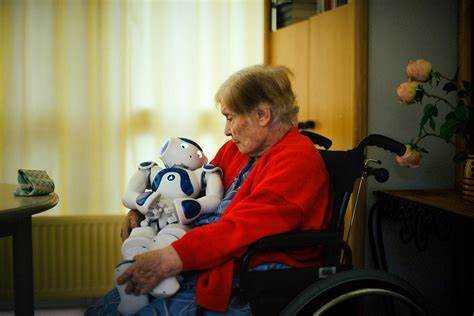
Later, a home care company that I follow on LinkedIn posted a video of a new pilot program they have started, where instead of an actual caregiver; a robot shows up at your door. The video showed an older woman opening the front door to what looked like a coat hanger on wheels with an iPad attached to the top. The general gist of the comments was “Wow, great way to incorporate new technologies into senior care.”
So, I need to say something.
I care A LOT about seniors living in a way that allows them to thrive. A LOT. I care about dignity, independence, and valuing them. That’s why robots bug me.
When we are working with seniors with dementia, there are dilemmas around whether products like the Parorobot are ethical ways of treating symptoms. If you haven’t seen this little guy, check him out. He’s a stuffed seal that interacts and gives feedback, stimulating emotions for those with dementia. Is it okay to allow those with dementia to be fooled into thinking this little thing is real? I don’t see why not. Some do. But we let our kids play with dolls. We name our cars. When I moved into my most recent home, I still couldn’t get rid of stuffed animals from my childhood. How is this different? Besides, no senior ever spent their life nurturing an actual baby seal. (Apologies in advance if you know a senior who spent their life nurturing a baby seal.) But baby seals are not what I am talking about.
Hand on hand caregiving is non-negotiable for wellbeing. Anyone who works with seniors knows the power of nearness, the power of touch, and the power of being present. The senior population deserves us to focus on how we can afford to have a human being with them when they need one. Rather than us figuring out cheaper substitutes we need to focus on making care affordable. Instead of solving the puzzle of staffing cases, we need to focus on improving the lives of caregivers so that more people are willing and able to take on the role.
We need to reevaluate our approach to caregiving. Not only is it healthier from a cognition level to have an actual person take care of an actual person, it’s also natural and instinctual. Robots or robot-hybrid caregivers can’t read the environment the same way a present caregiver can. By not being there, they miss things. It bothers me, and it should bother you, to see an iPad on a coat rack taking the place of a live human being that you can not only see and hear, but can touch, smell, and be present with.
The bigger issue here is the message we are sending our seniors by spending time answering the wrong questions about caregiving. It’s hard enough to need help. Imagine being at home and needing to bring in outside assistance. It’s a risk, and it involves trust. That’s why not everyone can be a caregiver, and that’s why so many don’t bring in help when they should. But by allowing robots to take over the jobs of physically present caregivers, we are telling our seniors that their care is a problem that needs to be solved, rather than a natural stage of life. Even worse, we are telling them that we want to be in their homes even less than they want us to be there.
There are roles for technology in caregiving for sure. However, when we spend time focusing on trying to bring technology into the home to solve our problem rather than theirs, we take two steps back in answering the right question. “How can seniors continue to thrive, and what do they need from us?”

